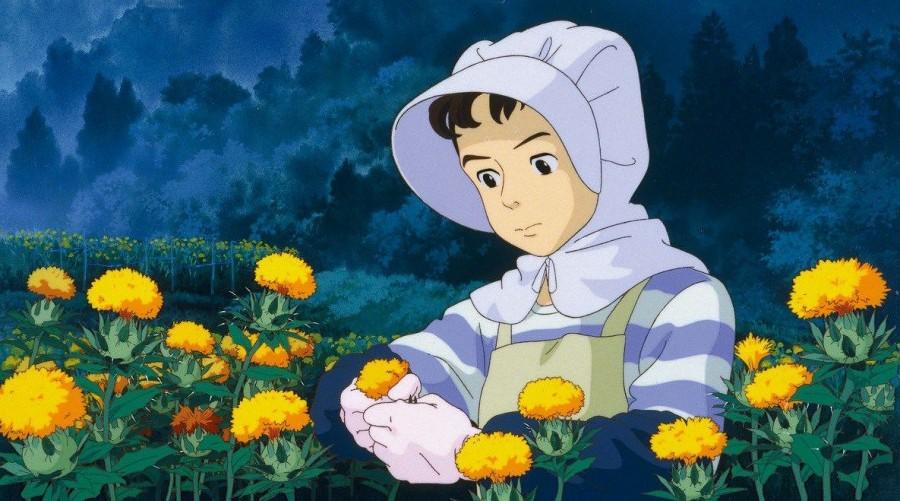Timeless Ghibli classic “Only Yesterday” remains just as brilliant as it was 25 years ago
April 13, 2016
Isao Takahata’s “Only Yesterday”, just released for the first time in the U.S., is a beautiful, thoughtful and resonant animated drama, another treat for fans of the studio responsible for “Spirited Away”.
It’s also hilarious.
“Only Yesterday” is another fantastic entry in Studio Ghibli’s oeuvre, the legendary studio responsible for classics like “Spirited Away” and “My Neighbor Totoro”. The film, originally released 25 years ago in Japan, is the only Ghibli film to have not yet been localized for American audiences.
“Only Yesterday” is built on an elegantly simple premise: protagonist Taeko takes a vacation from her intense job in Tokyo for the idyllic farm life of her brother-in-law’s family’s farm. It’s a strangely distant relation, but Taeko is too excited about the experience to be perturbed.
In reality, she goes to the countryside to avoid a profound instability within herself. Taeko is unmarried and lives alone, strange for a Japanese woman in the 1980s, where half of the film is set. She likes her job, but longs for something more. She isn’t sure if she’s happy. In essence, she goes to the countryside to “find herself”, but before she even arrives, these internal tensions bubble up to the surface in the form of childhood memories – specifically, from her time in fifth grade, 20 years before – which take up a good chunk of the running time.
Besides this, there is little plot in “Only Yesterday”, only hypnotic scenes of Taeko’s life before and now. When there is a climax, it’s based on her growth as a character. Compared to the hectic action of many modern animated films, it’s slower-paced, but immensely satisfying: the kind of film that lingers long after it cuts to black.
“Only Yesterday” is animated with a gorgeous, painterly feel that only adds to the tale. There are several stylistic choices which give the film a dreamlike tone. The flashbacks are drawn with much of the canvas left blank, almost unfinished, making them seem selective, the way memories usually are. The present day is, by contrast, rendered in lush detail. Unlike most animated films, special care is given to character’s faces – adults are wrinkled, worn down by time, while the children in Taeko’s flashbacks are endlessly glowing.
Despite the serious, reflective subject matter, the film is frequently funny, if uncomfortably so. The boys in Taeko’s grade school wonder why the girls are getting “weird-looking diapers” from the nurse as they learn about puberty; Taeko stuffs her face with pineapples she has fought hard to get despite loathing them; a young boy struggles to utter a word when he tries to ask Taeko out. All of these are funny and well-acted, but are underscored by sadness. It’s hilarious to see Taeko struggle with fractions, drawing apple diagrams that confound herself and her sister, but the laughter ends when her mother chastises her for failing math and yells, in a frustrated fit, that “Taeko is not a normal kid!”
When she isn’t reminiscing about her fifth-grade self, she enjoys the hard work of living on a farm and is in constant awe of the beautiful nature that surrounds her. She builds a perfect vision of life on the farm, one that she could enjoy, but Takahata is far too perceptive to let such a one-sided view take hold in her mind or the viewer’s.
Takahata subverts Taeko’s idyllic vision of the farm in one of the film’s most affecting sequences. Taeko and fellow farmhand Toshio converse about the “nature” that Taeko fawns over, a notion that Toshio immediately destroys: all the “nature” around her is controlled and paved, and most of the rivers she sees are manmade – much closer to her city than it is to actual nature. It’s profoundly unsettling for both Taeko and the viewer and raises even more questions and self-doubt within her.
The constant self-reflection doesn’t get tedious because it’s not aimless; with each scene Taeko and the viewer obtain more insight into who she is, and the portrait that forms is flawed, complicated and human. It’s the coming-of-age story to end all coming-of-age stories: Taeko comes into her own very late, at 27-years-old, and as such, has way more disparate experiences and ideas to bring together into a person. It feels far more epic in scope than an average bildungsroman because Taeko is supposed to know who she is by now but doesn’t. The stakes are higher and her journey is more complex than that of any hero, but the film is still intensely personal, and it packs a huge emotional wallop for it – “Only Yesterday” can, all of a sudden, be an absolute tearjerker.
An annoyed Taeko remarks, early in the film, that she has unwittingly been accompanied by her fifth-grade self for her trip to the countryside. By the film’s end, she sees her younger self on the train back to Tokyo and smiles, content to take her fifth-grade self and the rest of her, all of her, home.
“Only Yesterday” is now playing at Berkeley’s Shattuck Cinemas and Oakland’s New Parkway Theatre. Distributor GKIDS plans to release the film on DVD and Blu-ray sometime this spring.
Isao Takahata’s “Only Yesterday”, just released for the first time in the U.S., is a beautiful, thoughtful and resonant animated drama, another treat for fans of the studio responsible for “Spirited Away”.
It’s also hilarious.
“Only Yesterday” is another fantastic entry in Studio Ghibli’s oeuvre, the legendary studio responsible for classics like “Spirited Away” and “My Neighbor Totoro”. The film, originally released 25 years ago in Japan, is the only Ghibli film to have not yet been localized for American audiences.
“Only Yesterday” is built on an elegantly simple premise: protagonist Taeko takes a vacation from her intense job in Tokyo for the idyllic life of her extended family’s farm.
In reality, she goes to the countryside to avoid a profound instability within herself. Taeko is unmarried and lives alone, strange for a Japanese woman in the 1980s, where half of the film is set. She likes her job, but longs for something more. She isn’t sure if she’s happy. In essence, she goes to the countryside to “find herself”, but before she even arrives, these internal tensions bubble up to the surface in the form of childhood memories – specifically, from her time in fifth grade, 20 years before – which take up a good chunk of the running time.
Besides this, there is little plot in “Only Yesterday”, only hypnotic scenes of Taeko’s life before and now. When there is a climax, it’s based on her as a character. Compared to the hectic action of many modern animated films, it’s slower-paced, but immensely satisfying: the kind of film that lingers long after it cuts to black.
“Only Yesterday” is animated with a gorgeous, painterly feel that only adds to the tale. There are several stylistic choices which give the film a dreamlike tone. The flashbacks are drawn with much of the canvas left blank, almost unfinished, making them seem selective, the way memories usually are. The present day is, by contrast, rendered in lush detail. Unlike most animated films, special care is given to character’s faces – adults are wrinkled, worn down by time, while the children in Taeko’s flashbacks are glowing.
Despite the serious, reflective subject matter, the film is frequently funny, if uncomfortably so. The boys in Taeko’s school wonder why the girls are getting “weird-looking diapers” from the nurse as they learn about puberty; Taeko stuffs her face with pineapples she has fought hard to get despite loathing them; a boy struggles to utter a word when he tries to ask Taeko out. All of these are funny and well-acted, but are underscored by sadness. It’s hilarious to see Taeko struggle with fractions, drawing diagrams that confound herself and her sister, but the laughter ends when her mother chastises her for failing math and yells, in a frustrated fit, that “Taeko is not a normal kid!”
When she isn’t reminiscing about her fifth-grade self, she enjoys the hard work of living on a farm and is in constant awe of the beautiful nature that surrounds her. She builds a perfect vision of life on the farm, one that she could enjoy, but Takahata is far too perceptive to let such a one-sided view take hold in her mind or the viewer’s.
Taeko’s idyllic vision of the farm is subverted in one of the film’s most affecting sequences. Taeko and fellow farmhand Toshio converse about the “nature” that Taeko fawns over, a notion that Toshio immediately destroys: all the “nature” around her is controlled and paved, and most of the rivers she sees are manmade – much closer to her city than it is to actual nature. It’s profoundly unsettling for both Taeko and the viewer which raises even more questions and self-doubt within her.
The constant self-reflection isn’t tedious because it’s not aimless; with each scene Taeko and the viewer obtain more insight into who she is, and the portrait that forms is complicated and human. It’s the coming-of-age story to end all coming-of-age stories: Taeko comes into her own very late, at 27-years-old, and as such, has way more disparate experiences and ideas to bring together into a person. It feels far more epic in scope than an average bildungsroman because Taeko is supposed to know who she is by now but doesn’t. The stakes are higher and her journey is more complex than that of any hero, but the film is still intensely personal, and it packs a huge emotional wallop for it – “Only Yesterday” can, all of a sudden, be an absolute tearjerker.
An annoyed Taeko remarks, early in the film, that she has unwittingly been accompanied by her fifth-grade self for her trip to the countryside. By the film’s end, she sees her younger self on the train back to Tokyo and smiles, content to take her fifth-grade self and the rest of her, all of her, home.
“Only Yesterday” is now playing at Berkeley’s Shattuck Cinemas. The film is set to be released on DVD this spring.


